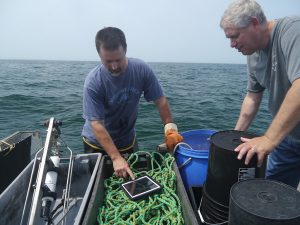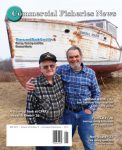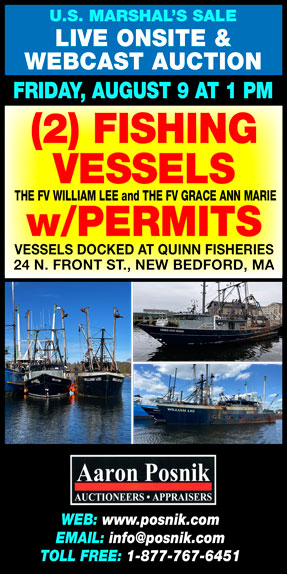KINGSTON, RI – Four years ago, the Commercial Fisheries Research Foundation (CFRF) launched its On-Deck Data Pilot Project to collect critically needed biological data – first, on American lobster, and then on the emerging Jonah crab fishery.
Between 2013 and 2015, a dozen vessels collected and recorded size, sex, and reproductive structure on lobsters and size at maturity on Jonah crabs – data which then was used to better inform the stock assessments.
“Outside of a few states performing their own ventless trap surveys, no one is surveying lobsters,” said Fred Mattera, CFRF president, marine safety trainer, and retired commercial fisherman.
“We’re really proud of what we’ve accomplished.”

Mike Marchetti, left, of the fishing vessel Mister G, and WHOI researcher Glen Gawarkiewicz at work as part of the CFRF shelf research fleet. (CFRF photos)
The CFRF initially launched the project using internal funds. Then, in 2015, a NOAA Saltonstall-Kennedy grant secured two more years of data collection.
The resulting four-year time series has helped inform the lobster stock assessment with offshore data and helped create a fishery management plan for Jonah crab.
It also set the stage for the foundation to apply the research fleet approach to data collection in other fisheries and for oceanographic monitoring.
“Over the past two years, CFRF has become more independent in pursuing and implementing projects that are important to the fishing industry,” said executive director Anna Malek Mercer.
“We have a growing staff and research capacity.”
Mercer, and research associates Aubrey Ellertson and Thomas Heimann, now staff four research fleets:
l The continuation of the lobster and Jonah crab study;
l A black sea bass study;
l A quahog abundance study; and
l Ocean climate data collection with Woods Hole Oceanographic Institute.
“It’s incredibly important for the fleet to contribute to the assessment and management of the species they fish. The fishermen own the data that they collect and can review it at any time,” said Mercer.
The research fleet studies are partially a response to changes in foundation funding, which Mercer said changed how they operate.
Previously, the foundation received federally earmarked funds, which were used to solicit collaborative research projects from other institutions.
Now. staff are actively conducting research hand-in-hand with the fishing industry, Mercer said.
“It’s been challenging to keep the foundation funded and in tune with the priorities of the fishing industry,” said Mercer.
But she has been seeking and awarded grants from a variety of competitive research programs.
“And we couldn’t do it without industry support,” Mercer said.
“It’s not easy after hauling the 50th pot to stop and start sampling,” Mattera said of the lobster fleet.
“But these guys have been awesome.”
Lobster and Jonah crab fleet research
The time series is fast approaching 100,000 lobsters sampled for the study “Supporting Management of the Emerging Jonah Crab Fishery and the Iconic Lobster Fishery in the Northeast USA.”
Fourteen commercial fishermen sample 300 lobsters per month, or 60 commercial traps. Three ventless traps are also sampled. Bottom temperature is recorded from a fixed site within each fisherman’s fishing area.
In addition to lobster sex and size, fishermen collect data on shell disease and hardness, notching, and data on the traps’ soak time, depth, and location.
When Jonah crabs were added to the…
 To get the MAY 2017 issue of Commercial Fisheries News, please choose from the following options:
To get the MAY 2017 issue of Commercial Fisheries News, please choose from the following options:
• BUY a Single PRINT edition of CFN that is delivered by MAIL. PRINT EDITION
• Quickly enjoy ONLINE access with our Hi-DEF flip-book. PURCHASE THIS ONLINE EDITION
• Shop the Online ARCHIVE
(Read online flip-book immediately with purchased access key and download a copy for yourself to keep. Not sure if it works for you? Try a FREE SAMPLE HERE.)
• SAVE BIG when you SUBSCRIBE!







